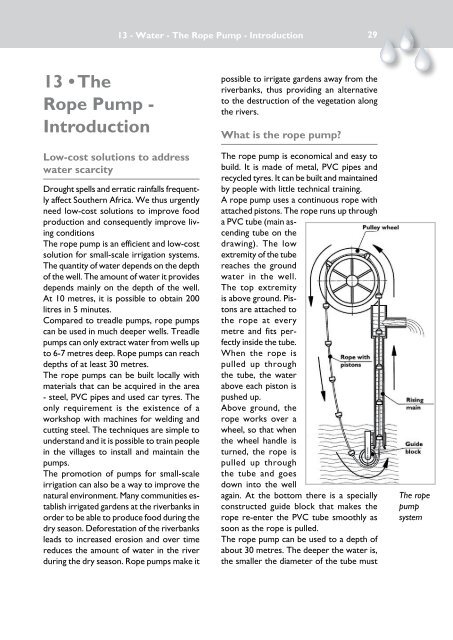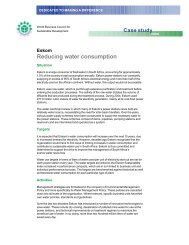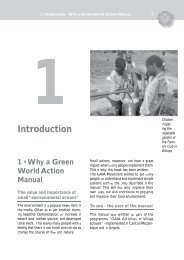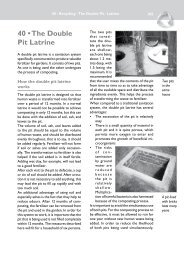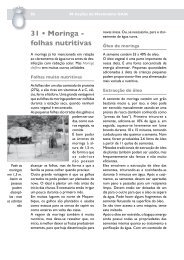• The Rope Pump - Introduction - The Gaia-Movement
• The Rope Pump - Introduction - The Gaia-Movement
• The Rope Pump - Introduction - The Gaia-Movement
You also want an ePaper? Increase the reach of your titles
YUMPU automatically turns print PDFs into web optimized ePapers that Google loves.
<strong>•</strong> <strong>The</strong><br />
<strong>Rope</strong> <strong>Pump</strong> -<br />
<strong>Introduction</strong><br />
Low-cost solutions to address<br />
water scarcity<br />
Drought spells and erratic rainfalls frequently<br />
affect Southern Africa. We thus urgently<br />
need low-cost solutions to improve food<br />
production and consequently improve living<br />
conditions<br />
<strong>The</strong> rope pump is an efficient and low-cost<br />
solution for small-scale irrigation systems.<br />
<strong>The</strong> quantity of water depends on the depth<br />
of the well. <strong>The</strong> amount of water it provides<br />
depends mainly on the depth of the well.<br />
At 10 metres, it is possible to obtain 200<br />
litres in 5 minutes.<br />
Compared to treadle pumps, rope pumps<br />
can be used in much deeper wells. Treadle<br />
pumps can only extract water from wells up<br />
to 6-7 metres deep. <strong>Rope</strong> pumps can reach<br />
depths of at least 30 metres.<br />
<strong>The</strong> rope pumps can be built locally with<br />
materials that can be acquired in the area<br />
- steel, PVC pipes and used car tyres. <strong>The</strong><br />
only requirement is the existence of a<br />
workshop with machines for welding and<br />
cutting steel. <strong>The</strong> techniques are simple to<br />
understand and it is possible to train people<br />
in the villages to install and maintain the<br />
pumps.<br />
<strong>The</strong> promotion of pumps for small-scale<br />
irrigation can also be a way to improve the<br />
natural environment. Many communities establish<br />
irrigated gardens at the riverbanks in<br />
order to be able to produce food during the<br />
dry season. Deforestation of the riverbanks<br />
leads to increased erosion and over time<br />
reduces the amount of water in the river<br />
during the dry season. <strong>Rope</strong> pumps make it<br />
- Water - <strong>The</strong> <strong>Rope</strong> <strong>Pump</strong> - <strong>Introduction</strong><br />
29<br />
possible to irrigate gardens away from the<br />
riverbanks, thus providing an alternative<br />
to the destruction of the vegetation along<br />
the rivers.<br />
What is the rope pump?<br />
<strong>The</strong> rope pump is economical and easy to<br />
build. It is made of metal, PVC pipes and<br />
recycled tyres. It can be built and maintained<br />
by people with little technical training.<br />
A rope pump uses a continuous rope with<br />
attached pistons. <strong>The</strong> rope runs up through<br />
a PVC tube (main ascending<br />
tube on the<br />
drawing). <strong>The</strong> low<br />
extremity of the tube<br />
reaches the ground<br />
water in the well.<br />
<strong>The</strong> top extremity<br />
is above ground. Pistons<br />
are attached to<br />
the rope at every<br />
metre and fits perfectly<br />
inside the tube.<br />
When the rope is<br />
pulled up through<br />
the tube, the water<br />
above each piston is<br />
pushed up.<br />
Above ground, the<br />
rope works over a<br />
wheel, so that when<br />
the wheel handle is<br />
turned, the rope is<br />
pulled up through<br />
the tube and goes<br />
down into the well<br />
again. At the bottom there is a specially<br />
constructed guide block that makes the<br />
rope re-enter the PVC tube smoothly as<br />
soon as the rope is pulled.<br />
<strong>The</strong> rope pump can be used to a depth of<br />
about 30 metres. <strong>The</strong> deeper the water is,<br />
the smaller the diameter of the tube must<br />
<strong>The</strong> rope<br />
pump<br />
system
A rope<br />
pump<br />
installed in<br />
a borehole<br />
also below<br />
0<br />
40 Green World Actions<br />
be to avoid the water<br />
column becoming<br />
too heavy.<br />
This means less water<br />
can be extracted<br />
from a deep well.<br />
Two different<br />
models<br />
<strong>The</strong> pole model<br />
This system is built<br />
with a handle fixed<br />
to two poles - see<br />
the drawing.<br />
Work can be made<br />
easier with handles<br />
at both sides of the<br />
well.<br />
<strong>The</strong> pole model can<br />
be installed in an<br />
open well, when the<br />
water is only used<br />
for irrigation. If the water is also used for<br />
drinking, the well must be covered with a<br />
concrete lid to ensure that the well water<br />
is not contaminated.<br />
<strong>The</strong> “A” model:<br />
<strong>The</strong> A model has a metal frame that is<br />
fixed to a concrete<br />
lid (see<br />
the drawing<br />
above).<br />
It can be installed<br />
over<br />
open wells<br />
or boreholes,<br />
and when the<br />
water is well<br />
p r o t e c t e d<br />
from contamination<br />
it is safe to drink.<br />
<strong>The</strong> pole model rope pump<br />
<strong>Rope</strong> pumps around the world<br />
50,000 pumps in Nicaragua,<br />
20,000 in Mexico, Guatemala, Honduras,<br />
Ghana, Zimbabwe, Zambia, Tanzania, etc.<br />
<strong>Rope</strong> pumps are produced by DAPP (Development<br />
Aid from People to People) in<br />
Shamva, Zimbabwe, by DAPP in Monze and<br />
Chibombo, Zambia, by ADPP in Chimoio<br />
and Bilibiza, Mozambique and soon by ADPP<br />
in Cabinda, Angola.<br />
Information and illustrations kindly supplied<br />
by:<br />
Henk Holtslag, holtslag.dapper@planet.nl<br />
Karl Erpf, SKAT, www.skat.ch<br />
Connect International,<br />
www.connectinternational.nl<br />
Jan de Jongh, Arrakis, www.arrakis.nl<br />
A wooden rope pump has been developed and<br />
is now made by local carpenters in Northern<br />
Mozambique
4 <strong>•</strong> Well Drilling<br />
- <strong>Introduction</strong><br />
<strong>The</strong> Rota-sludge method<br />
<strong>The</strong> manual excavation method, Rotasludge,<br />
is based on the sludge method,<br />
which has been employed to drill millions<br />
of wells in soft ground in Asia. Recently this<br />
method has been improved to make it more<br />
effective on harder ground. By training<br />
local organizations and craftsmen it is successfully<br />
being used in Nicaragua, Tanzania,<br />
Ethiopia, Senegal, Zambia, Mozambique and<br />
Zimbabwe.<br />
How it works<br />
<strong>The</strong> drilling mechanism consists of a bamboo<br />
or wooden lever, a 1½ to 2-inch drill<br />
pipe and an auger (soil drilling bit) with<br />
hardened teeth. To begin drilling, a starter<br />
hole is dug. <strong>The</strong> hole is connected to a<br />
shallow pit.<br />
This hole is then filled with drilling fluid,<br />
which consists of water and clay or cow<br />
dung (or bentonite if possible). <strong>The</strong> function<br />
is to make a thick fluid that can lift up the<br />
sand and clay. Another function is to plaster<br />
the sides of the well, so that the water does<br />
not disappear.<br />
<strong>The</strong> lever creates up and down movements.<br />
During the upward movement, the top of<br />
the drilling tube must stay closed. You can<br />
use your hand to close the top and create<br />
a vacuum. During the downward movement,<br />
remove your hand to open the pipe<br />
and allow the drilling fluid to flow back into<br />
the pit. <strong>The</strong> heavy particles and sand settle<br />
on the bottom of the pit while the “clean”<br />
drilling fluid flows back into the drill hole.<br />
As the hole gets deeper, new pieces of<br />
threaded pipe are added.<br />
4 - Water - Well Drilling - <strong>Introduction</strong><br />
<strong>The</strong> drilling<br />
b e c o m e s<br />
more efficient<br />
if the<br />
tube is rotated<br />
45 degrees<br />
at the<br />
moment the<br />
drilling tube<br />
touches the<br />
bottom of<br />
the hole. This technique allows the drill<br />
bit to scrape compact layers of sand, clay,<br />
sand stone or tuff stone. It does not work<br />
with solid rocks.<br />
“Baptist” drilling<br />
“Baptist” drilling is another low-cost drilling<br />
method. It was developed by Terry Waller<br />
at the Human Needs<br />
Project in Bolivia.<br />
Families are here<br />
trained and assisted to<br />
drill their own boreholes.<br />
<strong>The</strong>y drill up<br />
to 60 metres down<br />
through clay and sand<br />
with equipment made<br />
locally.<br />
<strong>The</strong> differences from<br />
the Rota-sludge system<br />
are:<br />
<strong>•</strong> the drilling bit has<br />
a valve<br />
<strong>•</strong> a rope and pulley<br />
is used<br />
<strong>•</strong> only bottom pipes<br />
are of steel. <strong>The</strong><br />
rest are of thick<br />
walled PVC, making the system easier<br />
to transport.<br />
See the photo next page.<br />
Information kindly provided by Henk Holtslag<br />
Rotasludge<br />
drilling in<br />
Northern<br />
Mozambique:15-<br />
20 m in<br />
3-4 days<br />
Teeths of<br />
drill bit<br />
from steel<br />
from truck<br />
springs


